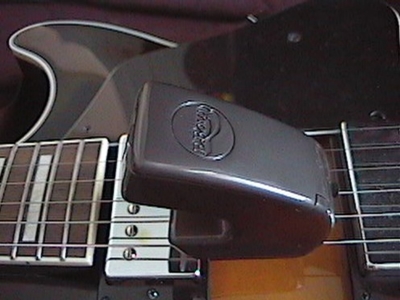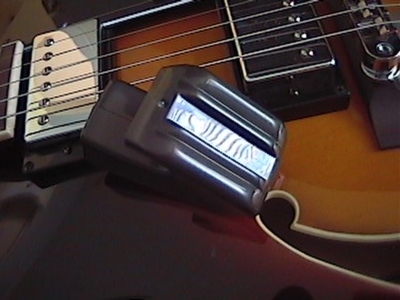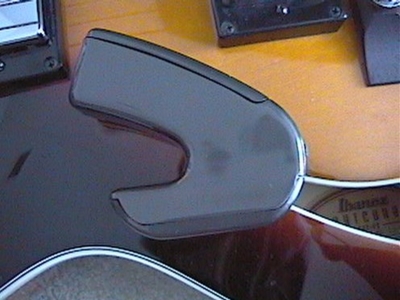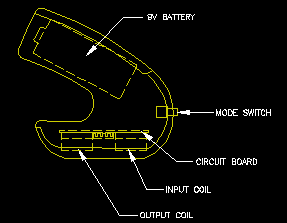The Technology of the Ebow
Created 05/18/07
Last updated 05/19/07
By Paul J. Marossy
After playing electric guitar for nearly twenty years and hearing it on all kinds of albums, I finally decided to pick one up - especially after seeing an old
Phil Keaggy video demonstrating his masterful use of one. A lot of people seem to like to complain about using the Ebow, but I've found that it's not that hard to learn to use one. It is something that takes some practice to use well, and I've found that you need a light touch with your right hand. If you're heavy handed, you're never going to be happy trying to use an Ebow, especially when changing to other strings or playing arpeggios.
Now, I have read various discussions about the Ebow, what it does, whether it can be built by a DIY-er, etc., but I never bothered with trying to make one after reading how much trouble people had to actually make one that worked properly. Building the circuit is one thing. Creating a practical, useable enclosure for it is another. Therefore, I do not advocate trying to build one yourself, but this is rather a discussion on what it is and how it does all the nifty things that it does.
Just as in my quest to understand how the wah pedal worked, I consulted the original patent documents filed in 1976 for hints about the secret inner workings of this unique device. After discovering how it works, I must say that it is one of the most clever, innovative, ground breaking inventions for electric guitar since the invention of the electric guitar itself. I think the same thing could be said about the Sustainiac sustain system as well - both of which use a similar method to simulate acoustic feedback (the classic electric guitar feedback sound). I won't say too much more because you can read all about the Ebow and its history at the official Ebow website.
The Ebow appears to be the first patented guitar sustainer device, filed under US Patents #4,075,921 & Des. 248,122. And, there have been several patents filed by many others - Alan Hoover (US Patents #4,941,388 & 5,932,827 & 6,034,316), a very interesting one by Hunter Menning (US Patent #5,449,858), Steve Shattil (US Patent #5,523,526) and even including several by Floyd Rose! (US Patents #4,907,483 & 5,123,324 & 5,233,123). The Fernandes sustainer system is filed under US Patent #5,585,588.
OK, finally on to how it works. The Ebow utilizes a pretty simple little LM386 IC chip based circuit operating on a 9V battery with an active area that is contained in space that is 2.0"x1.375"x0.5" inside of the base of the plastic enclosure. Basically, there's the LM386, an input coil, a driver coil and a LC feedback loop composed of one resistor and a capacitor to ground. The coils use a permanent magnetic core composed of ceramic magnets (patent states Alnico-5) and a steel slug around which are many turns of very small diameter enameled wire. These sense/cause the movement of the string. When the string is plucked, or if the Ebow is smply placed over the string, it will cause the string to vigorously vibrate. That movement is sensed by the input coil. This movement causes a magnetic field to occur, and it induces a current in the input coil. The electrical signal is then amplified by the LM386 and it produces a varying magnetic field of the same frequency in the output coil. The magnetic field of the output coil (driver coil) drives the string at its resonant frequency (sort of), and sustains the vibration of string.
In my testing, I have determined that the Plus Ebow actually operates at twice the fundamental frequency (2nd harmonic) in Normal Mode, and at three times the fundamental frequency (3rd harmonc) in Harmonic Mode. If you place the Ebow over a string that is not vibrating, it will excite the string into vibrating because of the positive feedback designed into the circuit. The circuit is designed so that it's on the verge of doing something but doesn't without a stimulus. When a guitar string is placed near the coils, it will cause the circuit to wake up and if in Normal Mode it will initially begin to oscillate at 2.4kHz, quickly transition to the 2nd harmonic (in approx. 70mS) and then bloom to max. voltage in approx. 1 second. In Harmonic Mode, a similar process takes place but this time the initial oscillator frequency is 2.6kHz. The white logo black Ebow, which predates the Plus Ebow, uses an initial oscillator frequency of 2.5kHz. This frequency appears to have been chosen because at that frequency there is a gain boost. It also conveniently takes advantage of string wave physics as the anti-nodes of the 2nd and 3rd harmonics are in the same area as the guitar pickups.
The inventor of the Ebow, Gregory S. Heet, also discovered that when the current thru the output/driver coil is reversed, the fundamental frequency of the string is damped - the harmonics (or overtones as the patent states) are accentuated and are driven more. This appears to be the "Harmonic Mode" in the current incarnation of the Ebow, called the PlusEbow. I have determined that it's not doing exactly what the patent states - this would require actually physically reversing the windings on the driver coil. Instead they chose to use an arrangement that produces the same result with a 1N4148 diode and an electrolytic capacitor. That diode, which has a 4.7uF capacitor in parallel, is acting as a filter and not strictly a polarity potection device. The internet schematics are all wrong in this regard. I explain all of these things in detail in my video series concerning the Ebow, which is linked at the bottom of this page.
When not using an already distorted guitar signal, where and how you place the Ebow in relation to the pickup determines what type of the many effects that you can get with the Ebow. Essentially, it's a controlled, predictable sustain feedback that is confined to a single string - Ebow calls this "Direct String Synthesis". And this simple little circuit delivers.
That's about all there is to it - a very simple, yet fascinatingly complex, ingenius device! A serious DIY-er might be able to build one of these if using a correct schematic, but I don't recommend trying it due to all the difficulties involved. There is one work-alike schematic that I have seen that uses an LM386 which has been confirmed to actually work, IF laid out correctly. The two major obstacles to overcome when attempting to build such a device is to build it so it does not just self-oscillate, and the other more insurmountable obstacle is coming up with the enclosure holding the circuit. Unless you can replicate one out of a thin plastic material, you're going to have some problems on your hands. Since the initial creation of this article, 3D printers have become ubiquitous, so it's possible to design and 3D print one, but good luck making one that actually works and is usable. My stance on this is, do yourself a favor and just buy one!
 |
This is how the Ebow sits on the strings. This is where it would be when it sounds the loudest (when using a non-distorted guitar tone). |
 |
This is how it looks from above. The battery fits under the cover with the Ebow logo on it. |
 |
This is the bottom of the Ebow showing the carefully designed grooves designed to sit on the guitar strings. |
 |
Here is a side view. The circuitry sits in the base of the unit. There is a very cleverly designed, compact PCB in there. Use of space is very efficient, indeed. |
 |
This is how the insides of the PlusEbow are laid out. The circuitboard and and coils are potted in something that appears to be a two-part urethane which fills the entire cavity where the circuitboard is housed. Many thanks to the individual who gutted one so I could find this out! |
I hope this page is informative to those who aren't familiar with the Ebow, and that it will satisify the curiousity of the happy, yet mystified Ebow owner.
VERIFIED Ebow Schematic & PCB Layout